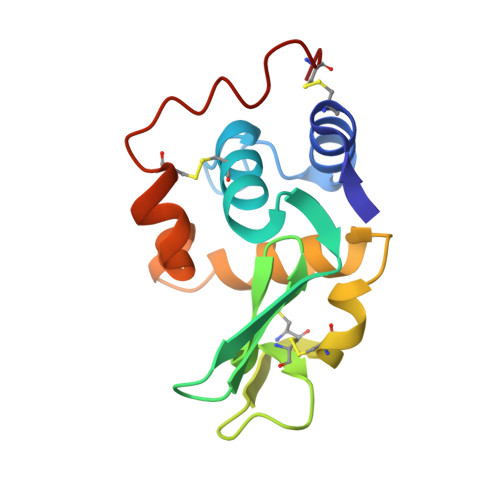Role of Arg115 in the catalytic action of human lysozyme. X-ray structure of His115 and Glu115 mutants.
Harata, K., Muraki, M., Jigami, Y.(1993) J Mol Biology 233: 524-535
- PubMed: 8105095
- DOI: https://doi.org/10.1006/jmbi.1993.1529
- Primary Citation of Related Structures:
133L, 134L - PubMed Abstract:
The structure of modified human lysozymes (HLs), in which Arg115 is replaced by His or Glu, has been investigated by X-ray analysis at 1.77 A resolution. The mutation of the 115th residue by His does not affect the backbone structure as indicated by a root-mean-square deviation (r.m.s.d) of 0.14 A for the superposition of equivalent C alpha atoms between His115 HL and wild-type HL. In contrast, the corresponding r.m.s.d. value for Glu115 HL is 0.38 A which is twice as large as the estimated co-ordinate error of 0.2 A. Movement of the backbone structure is observed in the region of residues 100 to 130, which give an r.m.s.d. value of 0.61 A and a maximum deviation of 1.46 A for Arg119. A significant movement is also observed in the region of residues 45 to 50, which are located at the opposite side of the region of residues 100 to 120 with respect to the active site cleft. As a result, the active site cleft of Glu115 HL is narrower than the cleft of His115 HL or wild-type HL. This structural change is considered to be responsible for the low catalytic activity of Glu115 HL and the change of the catalytic property found in the hydrolysis of oligosaccharides. The replacement of Arg115 by Glu changes the charge distribution in the molecule, and the change in the electrostatic field may affect polar interactions among residues. The side-chain group of His115 and Glu115 is almost parallel to the indole moiety of Trp34, but the carboxyl group of Glu115 is laterally shifted to avoid overlapping with the indole moiety. The carboxylate anion of Glu115, which does not favor the face-to-face contact with aromatic groups, may provide a driving force for the structural change. The prominent structural change caused by the single mutation suggests that Arg115 is a key residue in maintaining the structure of the active site cleft.
- Biomolecules Department, National Institute of Bioscience and Human-Technology, Ibaraki, Japan.
Organizational Affiliation:
















